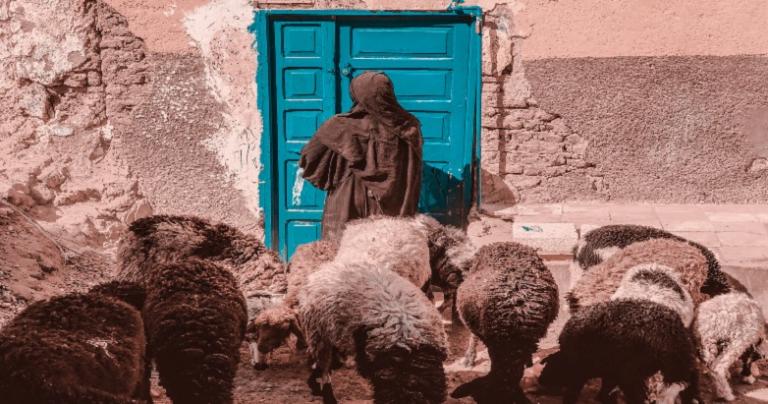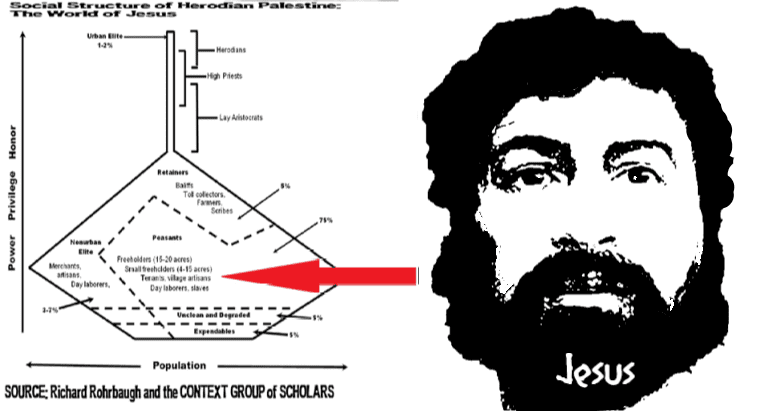OCTOBER 14, 2019 BY FELLOW DYING INMATE

Unhealthy Christology!—Our imagined Jesus and Mary are a far cry from the historical truth of starving Galilean peasants.
Is your imagined Jesus unhealthy? How do you picture the historical Jesus, physically speaking? Imagine Jesus walking about in first century Galilee. How does he appear? Did being God’s only begotten Son mean that Jesus was impervious to infectious disease, malnutrition, poor hygiene, nonexistent sanitation, tooth decay, parasites, bad eyesight, and rampant village violence—all common realities to his world?
Unhealthy Views of Jesus Divorce Him from Peasant Realities
Jesus was a peasant artisan in a hamlet called Nazareth. We are made to think of Jesus as a carpenter as per our faulty ethnocentric English translations, and the corresponding devotional image is often anachronistic to carpenters from 19th century abundance and 20th century superabundance. But the Greek word is tekton, and can refer to any Mediterranean lower class male working in wood or metal.

If Jesus’ family specialized in the yokes of oxen, as legend suggests, then his family would have been of the poorest in Israel. Far too many homilies pool the ignorance that the Holy Family was “Middle Class.” That’s completely bogus. Worse, it leads to unhealthy behavior unfit for those called to be Christians.
While larger Israelite villages and towns would showcase various craftsmen and artisans, this was not the same for tiny hamlets like Nazareth with just around 200 people. Without travel, Jesus and his family would assuredly starve. But such travel for survival marked itinerant artisans like Jesus as being socially deviant. In his society, only the degraded and expendables were beneath his family.
Unhealthy Picture
So picture Jesus standing in the village square for work as an artisan or day laborer. Looking at his parables, and what we know about peasants and their treatment from his time, it isn’t hard to catch glimpses of him. Read the parable of the tenants, or the parable of the day laborers.
Now consider also 45 to 60 migrant workers from our time, huddled together in a trailer without AC or running water, after a day of backbreaking work picking our avocados and tomatoes. They band together to pray in their humble gathering place. These are nothing-people, throw-away people—people like Jesus, Mary, Joseph, and their fellow villagers from Nazareth. Let’s take the “IN” of Incarnation, seriously.

Jesus, Peasant Artisan among Day Laborers
Although Jesus was an artisan, most days he would take work as a day laborer. To most ancients, day laborers ranked beneath slaves. They starved with fifty to 100 people in your village household complex, desperately scratching out survival. From where do the ingredients of Jesus’ parables come? These come from being terribly marginalized, crushed down by debt and poverty.
Workers like Jesus were not guaranteed a minimum wage. In fact, wages were depressed. Day laborers never got hired two consecutive days. Because of the epidemic of land foreclosure in Jesus’ time, numbers of competing day laborers soared, filling the village squares. They therefore had no bargaining power. The stewards who hired them held all the cards.
The Western individualistic strategy of job hunting was nonexistent in Jesus’ world. What these despised day laborers and itinerant artisans would do would be to wait around all day in the village square. They were not permitted to inquire about work opportunities—prospective hirers came to them. These people were treated like dirt, went without advocacy, survived on the margins, and always were near death, just a step away from being a soon-to-die expendable. This bleakness is the origin place of the prayer, “Give us this day our daily bread.”
Healthy Vision of Jesus
Given all of that, how do you picture Jesus? How did he physically look working in the Galilee? How handsome was he? How tall and robust was he? Was his hair clean and healthy-looking? And how about his teeth?
And how do you imagine his mother, Mary, the village peasant woman? Does she look like a German Goddess all dressed up in blue? Was she, back in first century Galilee, a healthy example of womanhood? Was she clean and well-manicured, with sparkling-white teeth of perfect dental health? Did she smell like roses?
Think of all the religious art where Mary and Jesus are depicted smiling. If the historical Mary or the prepaschal Jesus smiled at you, what would you see?
Unhealthy Distortions
Our Jesus movies (including Mel Gibson’s), Christian storybooks, religious clip art, devotional material, and Sunday school programs’ visual aids have damaged us in unhealthy ways. The nonsense that is the Shroud of Turin has set up psychological blocks to what is about to be presented.
No offense, but the ludicrous idea that we “know” what Christ looks like because we “know” that the Shroud of Turin must be the historical burial cloth of Jesus is nonscholarly opinion. The idea of the Shroud’s authenticity, held by some as if had dogmatic weight, is hotly contested by many scholars. Catholics are not obligated to believe it is real.
We have an unhealthy addiction to holy card sentimentality and 19th century romanticizing the peasant life of the Holy Family. Christmas pageants wrongly harmonizing “Matthew” and “Luke” reinforce our cheap grace feels.
Scholarly Corrections
These things are all deceits and distortions, honest ignorance or sincere stupidity that distance us from the truth of peasant life. Worse, they keep our parishioners and parishes mired in unhealthy status quo complacency, far from metanoia we desperately need! “Happy Birthday Jesus!” at Christmas time is an American fantasy. Scholar Richard Rohrbaugh explains:
“Birthrates in the first century were approximately forty per thousand per year, twice that in the U.S. today, though death rates were even higher still; hence in the modern world we have the curious phenomenon of far fewer births and a rapidly rising population. Infant mortality rates have been estimated at 30 percent in many peasant societies today, and that may well have been the case in first-century Palestine. Of the children who made it past infancy, a third were dead before the age of six. By age sixteen, 60 percent had died. By age twenty-six, 75 percent were gone and by age forty-five, 90 percent were dead. Only three percent made it to age sixty.”
(See The New Testament in Cross-Cultural Perspective by Richard Rohrbaugh and The Shape of the Past: Models of Antiquity by Thomas Carney, page 88)
Jesus Died an Old Man
Jesus died an old man—30ish was old for his world, folks! Four out of five people in his audience were younger than he was. The majority of these people, living in extremely unhealthy conditions, were facing death within a decade. During the first days of the Jesus Movement, most of the Twelve were probably in their teens. They were dirt poor and infectious disease ravaged their towns and villages.
If you were a peasant and reached 30 years old in Jesus’ world, you almost certainly suffered with terrible eyesight, teeth rotting out of your head, and internal parasites. Your inescapably unhealthy body would be ravaged by protein deficiency. One half of every comb recovered at digs from Qumran, Masada, and Murabbat show signs of lice with eggs—suggesting how unhealthy life was in Nazareth.
(See Death and Disease in Ancient Israel, pp. 146-59, by Joseph Zias and Ancient History of Palestine, p. 98 by David Fiensy)
Jesus’ Diet was Terrible & Village Life Knew Rampant Violence
Richard Rohrbaugh and other scholars inform us of the horribly insufficient diet of first century Galilean peasants. Says Rohrbaugh, approximately one-fourth the caloric intake of a male Palestinian peasant came from alcohol, with half of all calories from bread.
(Read The Diet of Palestine in the Roman Period—Introductory Notes, pp. 41-56 by Megan Broshi.)
Middle Eastern village life is agonistic. The same was true 2,000 years ago. Violence in Jesus’ village settings was routine. In the Gospel called “Mark” alone one finds fifteen reports of common Middle Eastern village violence (1:14; 1:45; 3:6; 3:27; 5:3; 6:16–28; 10:33–34; 12:1–8; 12:40; 12:41–44; 13:9–13; 14:1; 14:43–48; 15:7; 15:15–20).
(See “Jesus and the Economic Questions of His Day” and “The Countryside in Luke-Acts” in “The Social World of Luke-Acts: Models for Interpretation” pp. 152-64, by Douglas Oakman; edited by Jerome Neyrey.)
No Way to Control Infections
The gravest threat to life came by way of infectious diseases. Ancients had no means of controlling infection. Rural areas depended on shamanic folk healers like Jesus as professional physicians usually were out of the question. Modern physicians were unknown to the world of Jesus. Sanitation was nonexistent—this caused disease rates to soar.
Being Serious with the Prefix “IN”
Taking in all of this, how does Jesus—truly human!—and Mary, look now? Taking the “IN” of Incarnation seriously is a messy business! Love is a messy business! Can we love someone whom we grossly misrepresent?
Consider our parishes and dioceses! Do they look and smell of Jesus and Mary and people like them? Or are they too well-dressed, too successful, too clean?
There are moral limits to verbal orthodoxy. Saying Jesus is truly human is insufficient. Let’s live this truth, smell this truth, kiss this truth, invite this truth to sit next to us in our comfort-places where, all too safely, we speak about them. Our parishes should look very different if we do. Even a diocesan gala thrown for the benefit of the despised (and criminalized) poor and migrants are far away from where they languish.
Writing and at the Amazon Synod, Pope Francis continues this challenge, urging us to make Christ-the-poor a co-participant in our plans and workings to bridge the gap between the comfortable and the despised and starving “nothing people.”
Getting Real
Tossing crumbs from a soup kitchen is not Biblical mercy nor is it transformation. But a CEO or “successful” entrepreneur walking and smelling the garbage dump home of Christ-the-poor is the sign of incarnational empathy. Such face-to-face, heart-to-heart love incarnates a living confession that we, the well-off, are also terminally ill, but deluded by our vanity walls into a make-believe we are immortal, somehow removed from being born between urine and feces like Cornell West says, and soon to be a feast for worms as we must.
And it gives living flesh to love. Here is the true ontological! Here is the truly authentic life! This is the place of authentic Eucharistic life. Only here can sinful structures change. Will we see the real Jesus?
